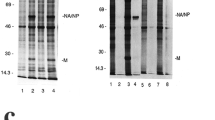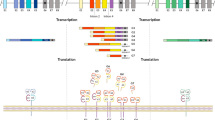Abstract
Responses to GLPhe5 were generated in vitro, using the GLPhe helper factor. A plaque assay, using GLPhe-coated SRC, was used to measure antibody responses to GLPhe. Mice of differentH-2 haplotypes were tested for the ability to produce the GLPhe helper factor or to respond to a known GLPhe helper factor. We report here defects in nonresponder mice of different strains in both the production of helper factor and in the capacity to respond to it.
Similar content being viewed by others
References
Benacerraf, B. and Katz, D.H.: The nature and function of histocompatibility-linked immune response genes. In B. Benacerraf (ed.):Immunogenetics and Immunodeficiency, pp. 117–177. Medical and Technical Publishing Co. Ltd., London, 1975
Benacerraf, B. and McDevitt, H.O.: Histocompatibility-linked immune response genes.Science 175:273–279, 1972
Beverley, P.C.L., Woody, J., Dunkley, M., Feldmann, M., and McKenzie, I.: Separation of suppressor and killer T cells by surface phenotype.Nature 262:495–497, 1976
Campbell, D.H., Garvey, J.S., Cremer, N.E., and Sussdorf, D.H. (eds.):Methods in Immunology, p. 273. W.A. Benjamin, Inc., New York, 1970
Chan, E., Mishell, R., and Mitchell, G.: Cell interactions in an immune response in vitro: requirement for theta-carrying cells.Science 170:1215–1217, 1970
Cheung, N.K.V., Dorf, M.E., and Benacerraf, B.: Genetic control of the primary humoral response to GLu56Lys35Phe9.Immunogenetics 4:163–170, 1977
Cunningham, A. and Szenberg, A.: Further improvements in the plaque technique for detecting single antibody-forming cells.Immunology 14:599–600, 1968
David, C.S., Shreffler, D.C., and Frelinger, J.A.: New lymphocyte antigen system (Lna) controlled by theIr region of the mouseH-2 complex.Proc. Natl. Acad. Sci. U.S.A.70:2509–2514, 1973
Dorf, M.E. and Benacerraf, B.: Complementation ofH-2 linkedIr genes in the mouse.Proc. Natl. Acad. Sci. U.S.A.72:3671–3675, 1975
Dorf, M.E., Stimpfling, J.H., and Benacerraf, B.: Requirement for twoH-2 complexIr genes for the immune response to the L-GLU, L-LYS, L-Phe terpolymer.J. Exp. Med. 141:1459–1463, 1975
Dorf, M.E., Twigg, M.B., and Benacerraf, B.: Genetic control of the immune response to the random linear terpolymer of L-glutamic acid, L-łysine and L-leucine (GLleu) by complementing Ir genes.Eur. J. Immunol. 6:552–556, 1976
Erb, P. and Feldmann, M.: Role of macrophages in in vitro induction of T-helper cells.Nature 254:352–354, 1974
Feldmann, M.: Cell interactions in the immune response in vitro. V. Specific collaboration via complexes of antigen and thymus-derived cell immunoglobulin.J. Exp. Med. 136:737–160, 1972
Feldmann, M.: Do immune response genes act on macrophages?Nature 267:105, 1977
Feldmann, M. and Basten, A.: Specific collaboration between T and B lymphocytes across a cell impermeable membrane in vitro.Nature (New Biol.) 237:13–15, 1972
Götze, D., Reisfeld, R.A., and Klein, J.: Serological evidence for antigens controlled by the Ir region in mice.J. Exp. Med. 138:1003–1008, 1973
Howie, S. and Feldmann, M.: In vitro studies onH-2 linked unresponsiveness to synthetic polypeptides. III. Production of an antigen specific T helper cell factor to (T,G)-A-L.Eur. J. Immunol. 7:417–421, 1977
Howie, S., Feldmann, M., Mozes, E., and Maurer, P.H.: In vitro studies onH-2 linked unresponsiveness. I. Normal helper cells to (T,G)-A-L and GAT in low and non-responder mice.Immunology 32:291–299, 1977
Julius, M., Simpson, E., and Herzenberg, L.: A rapid method for the isolation of functional thymusderived murine lymphocytes.Eur. J. Immunol. 3:645–649, 1973
Kapp, J.A., Pierce, C., and Benacerraf, B.: Genetic control of immune responses in vitro. I. Development of primary and secondary plaque forming cell responses to the random terpolymer L-glutamic acid60-L-alanine30-L-tyrosine10 (GAT) by mouse spleen cells in vitro.J. Exp. Med. 138:1107–1120, 1973
Kappler, J.W.: A micro-technique for hemolytic plaque assay.J. Immunol. 112:1271–1274, 1974
Katz, D.H. and Benacerraf, B.: Hypothesis-The function and interrelationships of T cell receptors, Ir genes and other histocompatibility gene products.Transplant. Rev. 22:175–195, 1975
Katz, D.H., Dorf, M.E., and Benacerraf, B.: Control of T-lymphocyte and B-lymphocyte activation by two complementing Ir-GLØ immune response genes.J. Exp. Med. 143:906–918, 1976
Merryman, C.F. and Maurer, P.H.: Genetic control of immune response to glutamic acid, alanine tyrosine containing copolymers in mice.J. Immunol. 108:135–141, 1972
Merryman, C.F., Maurer, P.H., and Bailey, D.W.: Genetic control of immune response to a glutamic acid, lysine, and phenylalanine copolymer. III. Use of recombinant inbred strains of mice to establish association of immune response genes withH-2 genotype.J. Immunol. 108:937–940, 1972
Merryman, C.F., Maurer, P.H., and Stimpfling, J.: Unigenic and multigenic I-region control of the immune response of mice to the GAT10 and GLØ-GLT terpolymers.Immunogenetics 2:441–448, 1975
Munro, A. and Taussig, M.J.: Two genes in the major histocompatibility complex control immune responses.Nature 256:103–106, 1975
Okumura, K., Herzenberg, L.A., Murphy, D. B., McDevitt, H.O., and Herzenberg, L.A.: Selective expression ofH-2 (I-region) loci controlling determinants on helper and suppressor T lymphocytes.J. Exp. Med. 144:685–698, 1976
Rittenberg, M.B. and Amkraut, A.: Immunogenicity of trinitrophenylhemocyanin: Production of primary and secondary anti-hapten precipitins.J. Immunol. 97:421–430, 1966
Rosenthal, A.S. and Shevach, E.M.: Function of macrophages in antigen recognition by guinea pig T lymphocytes. I. Requirement for histocompatible macrophages and lymphocytes.J. Exp. Med. 138:1194–1212,1973
Rosenthal, A.S., Barcinski, M.A., and Blake, I.J.: Determinant selection is a macrophage dependent immune response gene function.Nature 267:156–158, 1977
Schwartz, R.H., David, C.S., Sachs, D.H., and Paul, W.E.: T lymphocyte-enriched murine peritoneal exudate cells. III. Inhibition of antigen-induced T lymphocyte proliferation with anti-Ia antisera.J. Immunol. 117:531–540, 1976a
Schwartz, R.H., Dorf, M.E., Benacerraf, B., and Paul, W.E.: The requirement for two complementing Ir-GLØ immune response genes in the T-lymphocyte proliferative response to poly-(Glu53Lys36Phe11).J. Exp. Med. 143:897–904, 1976b
Schwartz, R.H., Yano, A., and Paul, W.E.: Gene complementation in the T lymphocyte proliferation assay: An analysis of the sites of expression of the two genes. In H.O. McDevitt (ed.):Ir Genes and Ia Antigens; pp. 297–304. Academic Press, New York, 1978
Shreffler, D.C. and David, C.S.: TheH-2 major histocompatibility complex and I immune response region: genetic variation, function and organization.Adv. Immunol. 20:125–195, 1975
Taussig, M.J., Munro, A.J., Campbell, R., David, C.S., and Staines, N.A.: Antigen-specific T cell factor in cell cooperation. Mapping within the 7 region of theH-2 complex and ability to cooperate across allogeneic barriers.J. Exp. Med. 142:694–700, 1975
Waldmann, H.: Conditions determining the generation and expression of T helper cells.Immunol. Rev. 35:121–145, 1977
Warner, C.M., Graves, R.M., Tollefson, C.M., Schmerr, M.J.F., Stephens, T.J., Merryman, C.F., and Maurer, P.H.: The immune response of allophenic mice to the synthetic polymer GLØ.Immunogenetics 3:337–348, 1976
Warner, C.M., McIvor, J.L., Maurer, P.H., and Merryman, C.F.: The immune response of allophenic mice to the synthetic polymer L-glutamic acid, L-lysine, L-phenylalanine. II. Lack of gene complementation in two non-responder strains.J. Exp. Med. 145:766–771, 1977
Author information
Authors and Affiliations
Rights and permissions
About this article
Cite this article
Baltz, M., Maurer, P.H., Merryman, C.F. et al. Complementation ofH-2-linkedIr genes: Use of helper factor to analyze responses to GLPhe. Immunogenetics 6, 471–481 (1978). https://doi.org/10.1007/BF01563938
Received:
Revised:
Issue Date:
DOI: https://doi.org/10.1007/BF01563938




